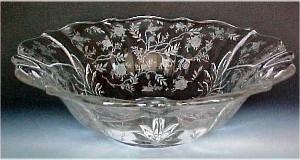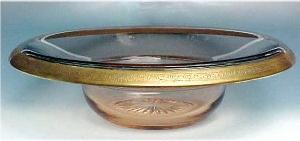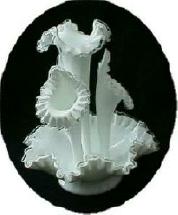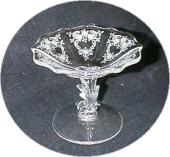National Depression Glass Association
Preserving America's Glass Manufacturing Heritage
Guide to decorative Elegant and Depression glass bowl shapes
by Kathy Eickholt
Elegant glass companies in the 1920s and 30s produced patterns
that included decorative pieces, stemware and dinnerware, but most
people who could afford glass such as Fostoria or Cambridge used
 china dinnerware. Thus glass firms
made many interesting bowl shapes for decorations and centerpieces.
Often these decorative bowls matched stemware lines, extending the
market appeal. Thus the console bowl was born!
china dinnerware. Thus glass firms
made many interesting bowl shapes for decorations and centerpieces.
Often these decorative bowls matched stemware lines, extending the
market appeal. Thus the console bowl was born!
Console Bowl
Console bowls were wide, shallow bowls that were meant to display on a side table or in a hallway. They are usually 10 to 12 inches wide and are flared. Some console bowls are deeper than others, but they are usually not so deep as salad bowls. Console bowls were often flanked by matching candleholders, and if you see something called a console set, it would be the console bowl with two candleholders.
The bowl in the picture (at left) is from Fostoria Glass. It is the Baroque blank and has the Chintz etching. You can see that this bowl is flared and quite fancy. It looks like it belongs on a table as a centerpiece. This particular bowl is referred to as a 12 inch flared round bowl. We have another Baroque bowl with the Lido etch that is about one inch narrower. Console bowls could be used to hold fruit or flowers, but were styled to have enough presence and size to look great empty as well.
Rolled-edge Console Bowl
 One of my personal favorites is the
rolled edge console bowl. Instead of flaring the rim to make a very
wide, shallow opening, the rim gracefully arcs over to form a wide
bowl with a much smaller opening. These bowls have looks! Usually
the etching or design is on the rolled rim. Since the interior of
the bowl is rolled to the outside, the design shows beautifully
from any angle. These are meant to be fancy and are one of the
signature pieces of the elegant era
One of my personal favorites is the
rolled edge console bowl. Instead of flaring the rim to make a very
wide, shallow opening, the rim gracefully arcs over to form a wide
bowl with a much smaller opening. These bowls have looks! Usually
the etching or design is on the rolled rim. Since the interior of
the bowl is rolled to the outside, the design shows beautifully
from any angle. These are meant to be fancy and are one of the
signature pieces of the elegant era
We just added the bowl shown at right to our website. This console bowl is from Tiffin, with a Minton gold trim on edge of the rolled rim. The photo shows the bowl in profile and you can see that the rim on this bowl does not roll fully over to touch the table top.
Centerpiece Bowl
Centerpiece bowls were usually slightly smaller than console bowls and came in a myriad of shapes. They would be used on a dining table, often with candles and flowers. Originally it was considered impolite to converse across the dining table with the person on the opposite side. Polite diners were expected to talk to the people on either side. Centerpieces were sometimes very tall, since it didn't matter whether one could see across the table. As time went on and we became more informal, it became acceptable to converse with your friend across the table and centerpieces were shorter. You can find truly hideous examples of elaborate silver or glass epergnes and such that are over two feet tall. These are usually older.
Lily PondSome bowls were very shallow, made to float roses or hold short-stemmed flowers. These may be called lily ponds or float bowls. Several elegant glass patterns such as Fostoria's American and Imperial's Candewick had multiple sizes of bowls that were shallow and meant to float flowers.
 Epergnes
Epergnes
Bowls that combine candleholders with an open section are epergnes. Usually these have cupped-shaped or horn-shaped holders to hold one to several candles. The candleholders may be raised slightly above the main bowl. These may look unusual to our modern eyes but make gorgeous, easy centerpieces when filled with flowers and candles. The epergne at left was made by Fenton.
Epergnes came in many styles, with varying numbers and shapes of
candleholders. We just added a Duncan Miller Sandwich pattern
epergne bowl to our website that is 12 inches wide with  a
single hole. This is the epergne base; the epergne horn would set
inside the hole. Some epergnes had horns that were deep enough that
they could hold flowers instead of candles. If the hostess enjoyed
arranging flowers, the epergne made it easy to create elaborate
designs.
a
single hole. This is the epergne base; the epergne horn would set
inside the hole. Some epergnes had horns that were deep enough that
they could hold flowers instead of candles. If the hostess enjoyed
arranging flowers, the epergne made it easy to create elaborate
designs.
Compotes or Comports
Besides decorative bowls, glass companies made comports, also called compotes. These are stemmed pieces that have a wider top. They were used to hold jelly or candy or could be used for small flower bouquets. The wide tops on the comports were perfect to show off etchings or cut designs. Pictured at right is a comport in Fostoria's Meadow Rose pattern. These were elegant pieces that could be drafted to serve a party or left on the table as an stylish decoration.
These fancy bowls were not limited to elegant glass from hand houses such as Cambridge or Fostoria. Mass produced glass patterns, such as from Anchor Hocking or Federal Glass, also included decorative pieces. We have an interesting footed fruit bowl in Federal Glass Yorktown pattern. Yorktown was a daily-use pattern that was mass produced in the 1950s to 70s. It has horizontal thumbprints that give it a colonial look.
Webmaster's NOTE: The NDGA wishes to thank the author for permission to use this article. Kathy is a dealer from Midland, Michigan. Her web site is Cat Lady's Glass.